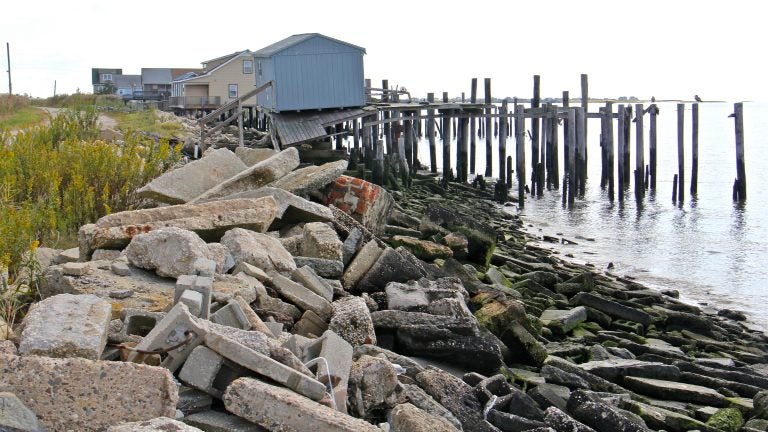Barriers, flood walls could help protect back bays, Army Corps says
The interim report foresees a ‘massive’ construction project costing ‘several billion dollars.’

A new study on how sea-level rise is affecting real estate values on the U.S. East Coast said Ocean City experienced the biggest slowdown of property prices among 20 cities studied between 2005 and 2017. (Emma Lee/WHYY)
This story originally appeared on NJ Spotlight.
Get ready for storm-surge barriers, floodwalls, and levees to protect New Jersey’s flood-prone back bays from sea-level rise, but don’t expect them to be built for at least another decade.
That’s the latest message from the U.S. Army Corps of Engineers, which is doing a massive multiyear study on how to defend the back bays from higher seas and bigger storms as the climate changes.
Many shore towns are seeing downward pressure on real estate prices amid growing public awareness that coastal properties are vulnerable to rising seas.
A new study on how sea-level rise is affecting real estate values on the U.S. East Coast said Ocean City experienced the biggest slowdown of property prices among 20 cities studied between 2005 and 2017 — greater even than Miami Beach, which is often seen as a poster child for the vulnerability of coastal cities.
Prices in Ocean City are now an aggregate $530 million lower than they would be without sea-level rise, according to the study from First Street Foundation, a Brooklyn-based nonprofit, and Columbia University. Seven other Jersey Shore towns were among the top 20 cities for real estate losses.
Among 17 states covered, New Jersey’s real estate losses were the second highest, at $4.5 billion, after Florida with $5.4 billion, the study said.
First word from Corps of Engineers
The Corps released an interim report on the early results of its work.
It said storm-surge barriers are “viable options” at several locations including Manasquan Inlet and Absecon Inlet but probably would be wrong for some other sites because their costs would outweigh benefits, and they could cause environmental damage.
To protect places including Cape May City, Stone Harbor/Avalon, and Ocean City, flood walls and levees are “potentially viable,” the report said.
But it warned that structural measures such as flood walls could spoil the views that draw many visitors or residents to the back bays and could lead to the loss of natural habitats.
Raising the roof
Another option would be to raise houses, as is now required for new construction in many areas of the Shore following superstorm Sandy in 2012. It also said there are environmental benefits to buying the most vulnerable coastal properties and turning the land into open space that becomes a buffer to rising seas — a policy that’s already followed by New Jersey’s Blue Acres program.
Nature-based coastal defenses like living shorelines and reefs could also play a part, it said.
And it warned that its primary focus is on managing the risk associated with storm-surges rather than so-called nuisance flooding that typically occurs because of the failure of storm sewers, which are not a federal responsibility.
Whatever options are finally chosen, they will likely be “massive in scale” and may cost “several billion dollars,” said the Army Corps, which is working with the New Jersey Department of Environmental Protection.
The feasibility phase of the study isn’t expected to end until 2022, and construction would start, assuming Congress appropriates the money, no earlier than 2030. By that time, the sea level at the Shore is expected to have risen by 0.8 feet, according to a Rutgers University projection in 2013. The anticipated start of construction appears to have been pushed back from an estimate of 2026, made only last September.
By 2050, sea levels at the Shore are expected to rise 1.5 feet, and another 2 feet by 2100, according to the Rutgers research.
The back bays’ shoreline is expected to see increased flooding, changes in salinity, greater inundation at high tide, and decreased capacity for stormwater drainage, as seas rise and storms become more ferocious, in line with climate-change models, said the report, titled the Coastal Storm Risk Management Interim Feasibility Study.
Back-bay challenges
Protecting the back bays is especially challenging because of their combination of flat topography, densely populated residential and commercial areas, low-lying infrastructure, and already degraded coastal ecosystems, the report said. “Addressing these problems requires a paradigm shift in how we work, live, travel, and play in a sustainable manner, as a large extent of the area is at a very high risk of coastal storm damage as sea levels continue to rise,” it said.
The DEP called the report a “milestone” in developing a comprehensive flood-mitigation strategy for the 950 square-mile area that covers 3,400 miles of shoreline in five counties. The DEP is working on its own Coastal Resilience Plan to protect the Shore from rising seas.
“New Jersey is particularly vulnerable to the impacts of sea-level rise caused by climate change,” DEP Commissioner Catherine R. McCabe said in a statement. “The DEP and the Army Corps are committed to ongoing public dialogue on solutions needed to make our economically vital and environmentally fragile coastline more resilient.”
Since Hurricane Sandy, the DEP’s Blue Acres program has purchased 648 vulnerable coastal properties, and has completed 531 demolitions, the agency said last September. The land is converted into open space to act as a flood barrier. Last fall, the program moved into Atlantic County and began talks with some residents of Pleasantville.
WHYY is your source for fact-based, in-depth journalism and information. As a nonprofit organization, we rely on financial support from readers like you. Please give today.




